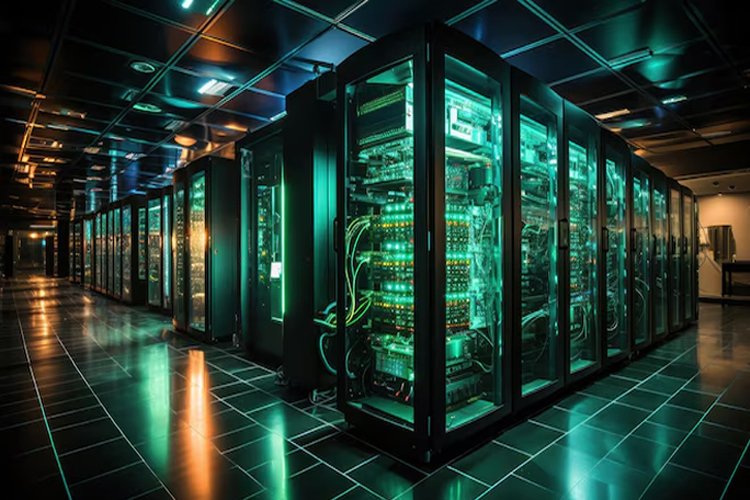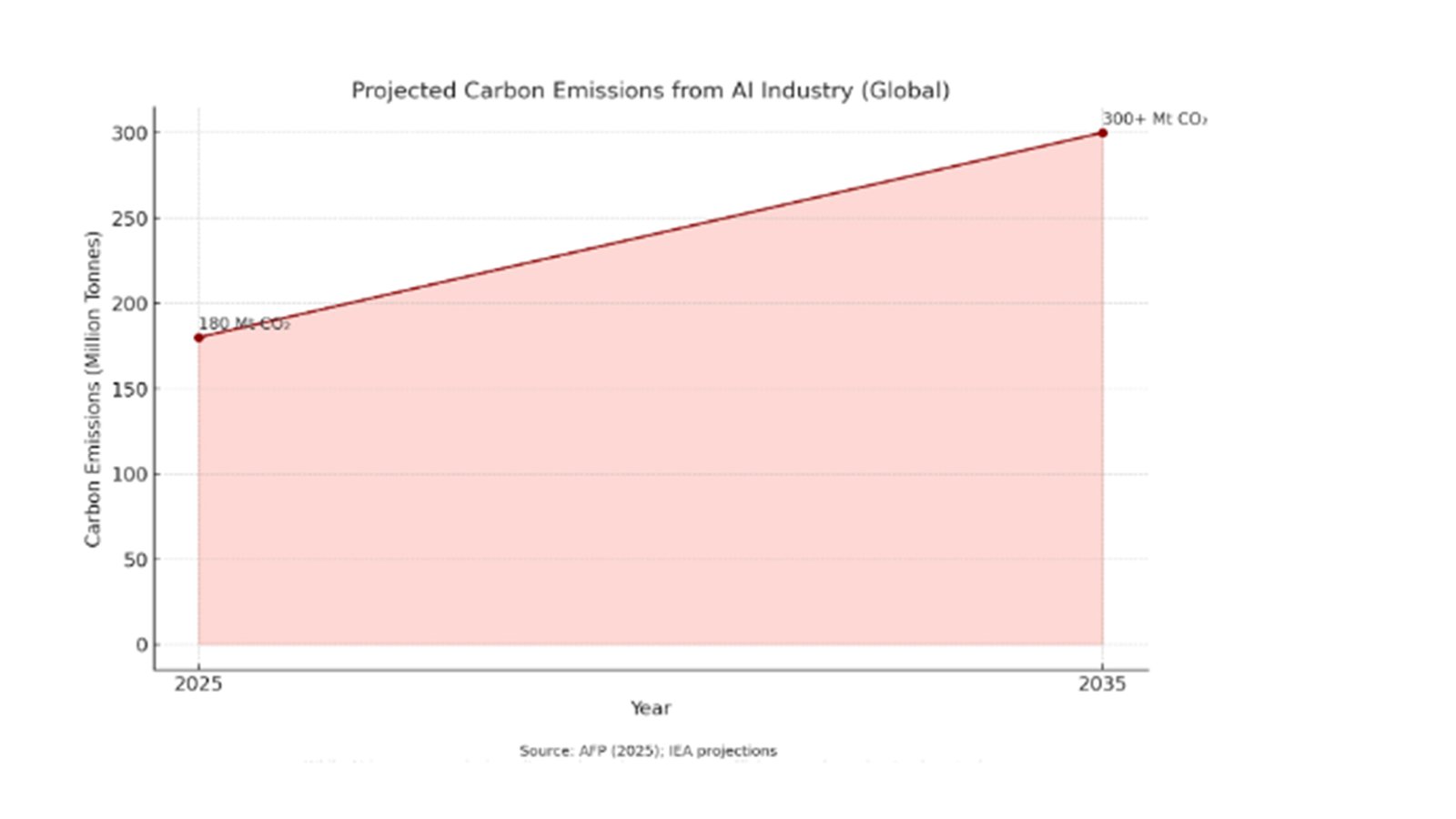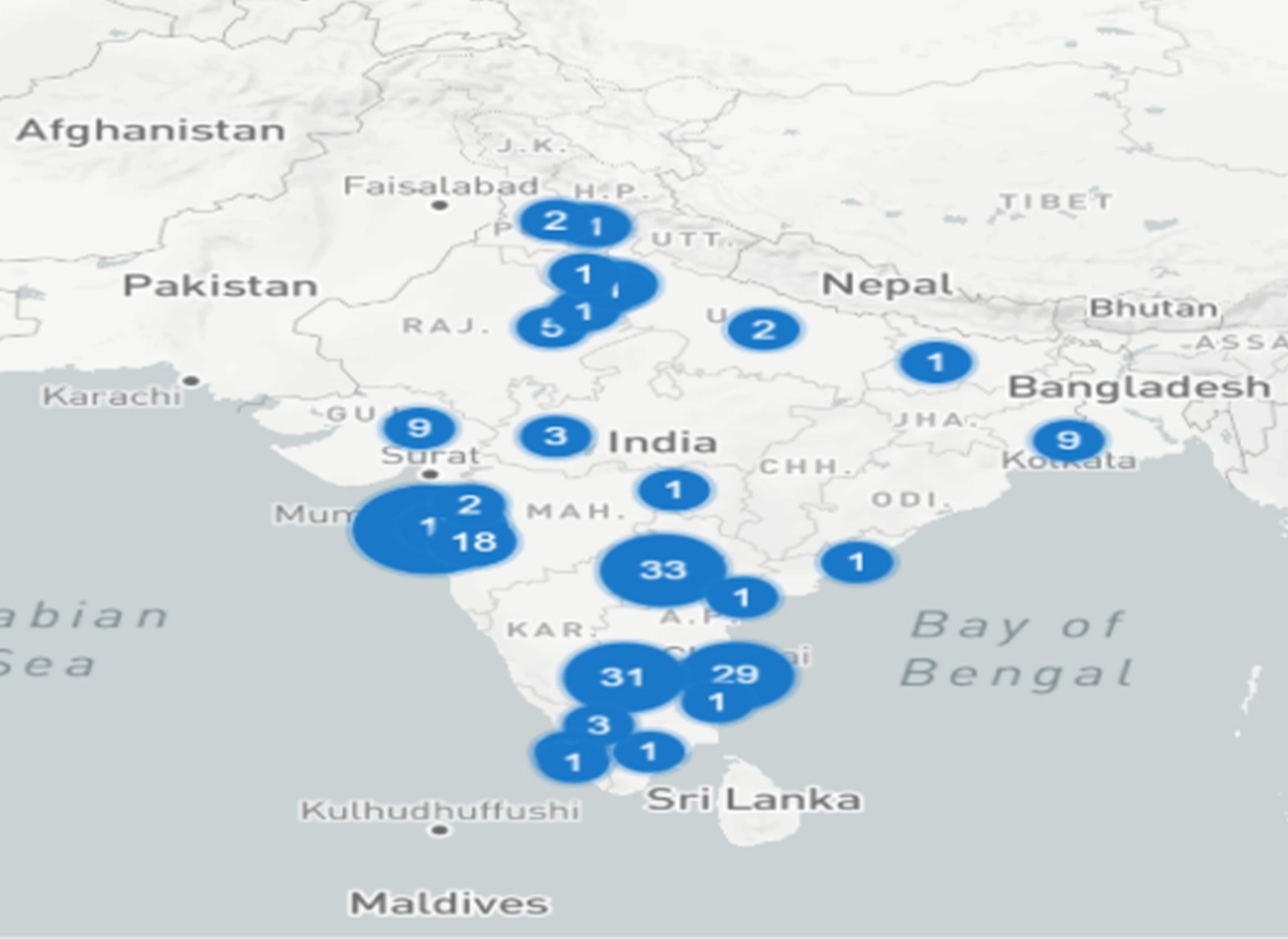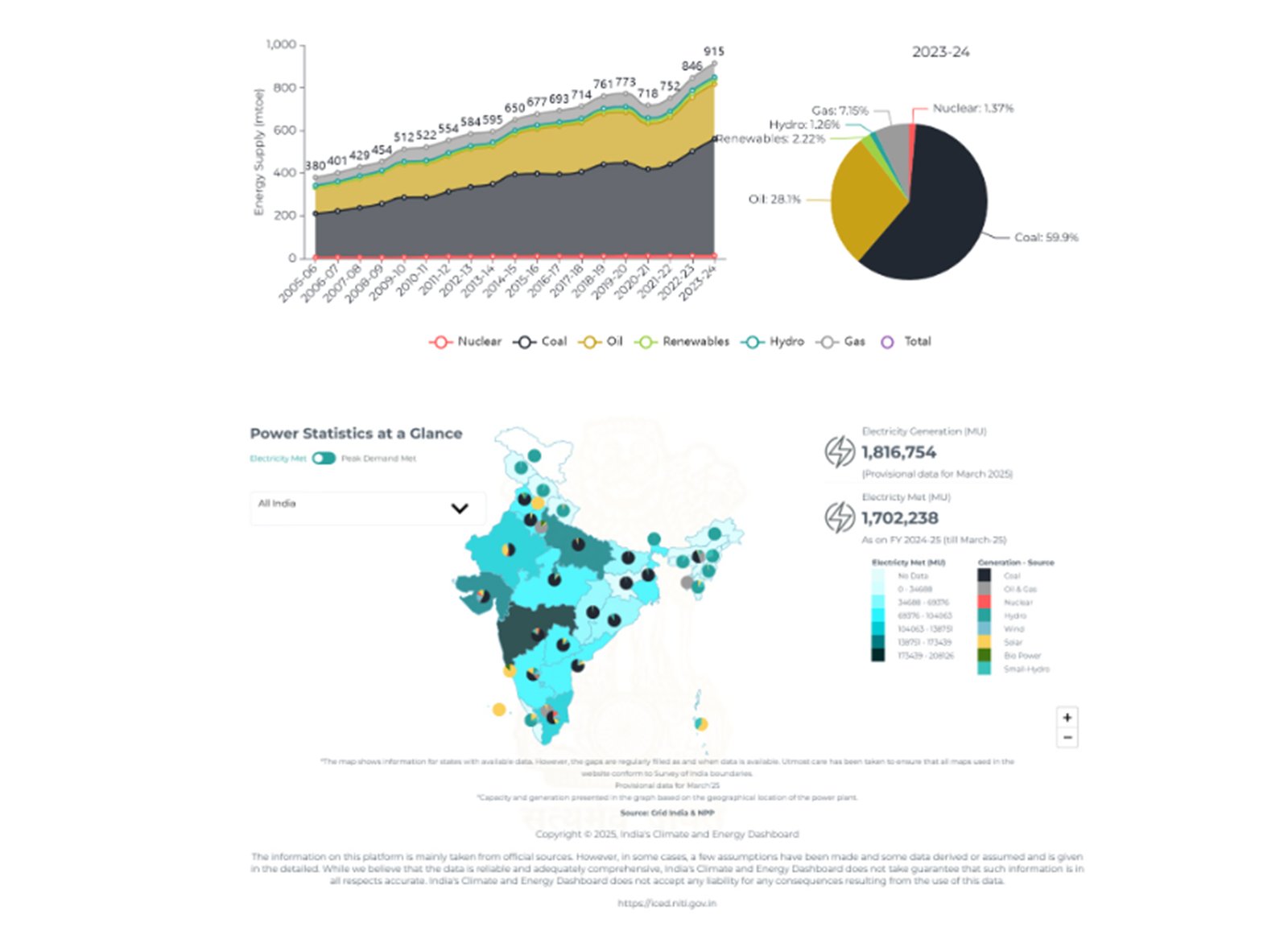India’s digital economy is expanding rapidly, driven by a strong push toward digital and artificial intelligence (AI) transformation. At the heart of this technological shift is the growth of massive data centres across the country, built to meet the rising demand of the technological revolution. Data centres serve as the brains or engines of AI, cloud computing, and the broader digital infrastructure. Every Siri response, Google search, or ChatGPT reply relies on powerful hardware housed within these facilities.
Data centers are industrial-grade complexes housing high-performance computing hardware such as GPUs, TPUs, and NPUs that are used to train and deploy AI models. In addition to powering AI, data centres store, process, and transmit much of what we do online, from cloud services to streaming, communication, and digital transactions. During all these processes they release a lot of heat which can slow them down, damage components, or even cause shutdowns. Hence, these data centers require constant cooling systems, just like laptops. Hence, in addition to the electricity required to keep these systems running, a significant portion of energy consumption in data centres goes into cooling the machines, often using water based cooling. For the purpose of cooling data centers several methods exist from air-based cooling, liquid based cooling to evaporative (adiabatic) cooling just to mention a few. Therefore, data centers require power for servers, for cooling systems and backing it all with generators, batteries and redundancies to ensure that nothing ever goes down.
ENERGY COST OF THE SILENT COMPANION OF AI REVOLUTION
The convenience of AI comes at a hidden environmental cost and a significant carbon footprint that is comparable in some cases to the total emissions from several gasoline cars over their entire lifespan. Recently, on Ghibli trend OpenAI CEO Sam Altman candidly remarked, “It’s super fun seeing people love images in ChatGPT, but our GPUs are melting,” 1 highlighting the strain AI is putting on global energy infrastructure, majorly depending on fossil fuels. In 2024, data centers consumed about 1.5% of the world's electricity, with their use increasing by 12% annually over the previous five years. China, Europe, and the United States account for around 85% of this energy use, but India is rapidly emerging as the major player. 2 According to a recent report by the International Energy Agency, in April 2025, titled, ‘Energy and AI,’ data centers' power usage, which is mostly driven by AI applications, is predicted to more than double by 2030, reaching around 945 terawatt-hours (TWh). That exceeds the current consumption of Japan, one of the most developed countries in the world.3 One of the main causes of this increase in recent years is generative AI, which requires enormous amounts of processing power and handles large volumes of data.
Despite concerns, countries in bid to be at the forefront of the AI race are now aggressively pursuing policies that attract investment in data centers expansion without considerably accounting for its environmental impact.
Currently the U.S. houses the largest number of data centers in the world and Virginia(Ashburn) is called the ‘world capital of data centers’ which handles 70 percent of world internet traffic every day. Data centers in the U.S. are projected to consume more electricity by 2030 than the entire industrial sector, this push aims to meet skyrocketing energy demands. A mid-sized data center in the U.S. requires as much water per day as 100,000 families.4 Tech behemoths like Google, Microsoft, and Amazon are increasingly turning to nuclear energy as a reliable power source in response to this rising demand. However, under the new Trump administration, there is an increased focus on using fossil fuels to meet the energy demands of AI data centres and to stabilize the power grid. Reflecting this priority, President Trump signed an executive order to explore whether coal can be classified as a “critical mineral” and a “critical material.”
In China, most of the country’s data centres are located in the eastern region, their energy supply is currently heavily dependent on coal, which accounts for about 70% of the mix. This is followed by renewables at nearly 20%, nuclear at close to 10%, and natural gas making up the remainder. However, China is actively increasing the share of nuclear power in data centre electricity supply, aiming for nuclear and renewables to collectively account for 60% of the energy mix by 2035.
Graph 1: AI - related Carbon Emissions Forecast (2025-2035)
CAN INDIA SUSTAIN ITS DATA CENTER SURGE?
India currently has 262 data centers as of 30th April 2025. By 2030, India's current 960 MW data center capacity could nearly double to 9.2 GW, according to Nomura's forecasts. 6 Meanwhile, a report by Anarock Capital estimates the value of India’s data center industry at $10 billion, generating approximately $1.2 billion in revenue during the financial year 2023–24 (FY24). Major metropolitan tech hubs like Mumbai, Chennai, Bengaluru, Hyderabad , Noida and the National Capital Region (NCR) are at the forefront of India’s data centre boom. About 70% of the nation's IT power capacity is shared between Chennai and Mumbai, with 49% coming from Mumbai alone. Chennai experienced a startling 340% increase in capacity between 2022 and 2024, while Mumbai's capacity nearly doubled.7 Other cities are also emerging as major participants, including Hyderabad (4%), Bengaluru (8%), Pune (5%), and Noida (9%). Strong market demand and operational momentum are reflected in high occupancy rates of about 76%.8 India is also focussing on establishing edge data centers in Tier-2 and Tier-3 cities such as Jaipur, Kochi, Vizag, Lucknow, Patna, and Bhubaneswar.
Image 1: Data Centres in India
Data centers are witnessing tremendous growth but as India positions itself to become a global data center hub, it is crucial to critically examine the environmental costs that it brings with it.
In 2022, data centers used between 1% to 1.5% of the world's electricity, but according to the IEA, AI will be the main factor driving this increase, which may reach 8% by 2030.10 By the end of the decade, data centers in India may account for as much as 3% of the nation's electricity consumption, up from the present 0.5% according to Nomura estimates. The increasing demand from data infrastructure might put additional strain on supplies in India, where many urban areas are already struggling with water scarcity. This would put industry, agriculture, and urban water and energy security at danger.
India is increasingly emphasising on green and sustainable data centers for example, in Jamnagar, for example, Reliance is constructing gigawatt-scale AI data centers that run solely on renewable energy.11 Companies such as Princeton Digital Group have announced billion-dollar investments to construct AI-ready data centers with liquid cooling, high-density racks, and load-bearing floors.12 The infrastructure itself is getting smarter; companies like Yotta and Sify are utilizing AI to forecast maintenance requirements, improve cooling systems, and track energy consumption in real time.13 In addition to increasing efficiency, these actions are helping lower carbon emissions and operating expenses.
States across India are adopting diverse strategies to power their growing data centers. Tamil Nadu under its data center policy outlines that in order to get incentives data centers must meet at least 30% percent of their energy needs from renewable energy sources with subsidies for using solar and wind. Karnataka has indeed taken the lead on eco-friendly measures in its Data Centre Policy by removing the 5 MW cap on green-power tariff reimbursement and tying key incentives to renewable-energy usage. Karnataka previously limited data centres’ eligibility for green-power tariff reimbursement of up to ₹1.25 crore.
Despite ongoing efforts, India's energy infrastructure remains vulnerable, constrained by the limited availability of renewable resources due to geographical and climatic factors. Establishing data centers in water-scarce or drought-prone regions risks exacerbating existing water stress and triggering social tensions. With the country's energy mix still heavily reliant on fossil fuels, it is crucial for India to realign its infrastructure strategy to ensure sustainability and resilience in the face of growing digital demands.
BUILDING SMART AND SUSTAINABLE DATA CENTERS
While India is rapidly expanding its data center footprint, sustainable growth demands more than just attractive policy incentives. To ensure long-term viability, environmental sustainability must be embedded from the outset in infrastructure, site planning, energy sourcing, and regulatory governance.
Strategic Siting and Ecological Safeguards
Avoid fragile ecosystems- Site selection must be based on rigorous environmental impact assessments, prioritizing areas with minimal ecological sensitivity and avoiding zones with high biodiversity or water stress.
Context-sensitive locations- Favour naturally cooler regions with reliable access to clean energy to reduce cooling loads and carbon emissions.
Zoning regulations- States should introduce carefully drafted zoning regulations that are needed to avoid any disturbances to residential areas, which might become an issue of concern in the longer run, with proper consideration for the future expansion of data center infrastructure. Clarity regarding zoning laws is also required, as currently not every state policy provides clarity regarding data centers. Since states like Tamil Nadu and Rajasthan do not have zoning restrictions, this allows data centers to be established in any area, including residential and green land, which could have a substantial impact on the environment such as noise and air pollution in residential areas.
Clean and Resilient Energy Mix
Mandate renewable sourcing- Set minimum thresholds for renewable energy sourcing (e.g., Tamil Nadu’s 30% requirement), with incentives tied to compliance.
Incorporate Small Modular Reactors (SMRs)- Include SMRs in India’s energy strategy as a low-carbon, reliable supplement to solar and wind, particularly for high-demand digital infrastructure. Their proximity to data hubs reduces transmission loss and increases energy security.
Grid resilience and forecasting- Proactively map and predict future energy demand to align infrastructure development with industrial growth and avoid future bottlenecks.
Efficient Cooling and Resource Use
Adopt liquid and advanced cooling technologies- Transition away from energy- and water-intensive air-cooling systems in favour of liquid cooling or other efficient alternatives.
Reuse and recycle- Promote heat reuse systems where waste heat from data centers can be redirected for productive uses such as heating or industrial processes.
Policy, Governance, and Stakeholder Alignment
Mandatory environmental assessments- Require pre-construction Environmental Impact Assessments (EIAs) focused on water, energy, and local biodiversity.
Stakeholder engagement- Involve local communities, ecological experts, and urban planners in siting decisions to ensure local knowledge informs national policy.
Collaborative governance- Partner with state governments, regulatory bodies, and industry associations like NASSCOM to harmonize policies and accelerate implementation of green norms.
Transparency, Incentives, and Innovation
ESG reporting requirements- Mandate public disclosure of energy, water, and resource consumption to improve transparency and build public trust.
Performance-linked incentives- Provide financial incentives for data centers achieving high benchmarks in operational efficiency and sustainability (e.g., energy use, emissions, water reuse).
Invest in R&D- Support innovation in energy-efficient hardware, modular designs, raised-floor layouts, and AI-based resource optimization to drive continuous improvement in efficiency.
CONCLUSION
Energy concerns cannot be an afterthought in this entire process, but rather a necessary preliminary step to ensure that these new types of infrastructure remain green and sustainable. These suggestions might appear to increase bureaucratic hurdles, but in the long run, they will prove to be a win-win situation for all stakeholders involved. India stands at a pivotal moment and by learning from global experiences where rapid data center proliferation has led to local backlash over environmental and health concerns, India can plan smarter. Sustainability must be integral, not incidental, to digital infrastructure development. A green data economy is not just an environmental imperative but a competitive advantage in a climate-constrained world.
References
1. https://www.iea.org/news/ai-is-set-to-drive-surging-electricity-demand-from-data-centres-while-offering-the-potential-to-transform-how-the-energy-sector-works
2. https://www.japantimes.co.jp/environment/2025/04/10/ai-data-center-electricity/#:~:text=Data%20centers%20represented%20about%201.5,information%20accumulated%20in%20gigantic%20databases.
3. https://economictimes.indiatimes.com/tech/technology/ai-surge-to-double-data-centre-electricity-demand-by-2030-iea/articleshow/120150317.cms?from=mdr
4. https://www.business-standard.com/industry/news/indian-data-centre-industry-valuation-investment-anarock-report-125032400625_1.html
5. https://ieefa.org/resources/blue-seas-and-green-electrons-powering-indias-ai-data-centres#:~:text=Most%20of%20the%20incremental%20electricity,scenario%20%E2%80%93%20a%20whopping%20ninefold%20expansion.
6. https://www.mercomindia.com/data-centers-drive-demand-for-renewable-energy
7. https://think.ing.com/articles/data-centres-growth-in-water-consumption-needs-more-attention/
8. https://www.thebridgechronicle.com/news/mumbai-and-chennai-record-explosive-data-center-growth-340-per-cent-surge-in-chennai
9. https://www.ndtvprofit.com/technology/over-65-billion-investment-committed-in-indias-data-centre-sector-in-a-decade-report
10. https://www.financialexpress.com/life/technology-reliance-to-build-worlds-largest-ai-powered-data-center-in-jamnagar-with-30-billion-investment-3724737/#:~:text=Reliance%20Industries%2C%20led%20by%20Mukesh,artificial%20intelligence%20(AI)%20services.
11. https://cio.economictimes.indiatimes.com/news/data-center/data-centre-firm-princeton-digital-group-to-invest-1-billion-expand-capacity-in-india/113511485
12. https://www.techcircle.in/2024/12/17/how-ai-boom-is-driving-india-s-data-centre-expansion
13. https://www.outlookbusiness.com/in-depth/indian-firms-ai-dream-has-a-power-problem#:~:text=%E2%80%9CAs%20of%20June%202023%2C%20India%27s,as%20a%20source%20of%20energy
14. https://www.goldmansachs.com/insights/articles/AI-poised-to-drive-160-increase-in-power-demand
15. https://dailyreporter.com/2025/04/08/ai-data-centers-nuclear-energy-doe-sites/
16. https://manufacturing.economictimes.indiatimes.com/news/hi-tech/data-centres-energy-demand-to-be-mapped/118580708#:~:text=The%20government%20has%20initiated%20an,the%20industry%2C%20they%20told%20ET.
17. India's data centre industry now worth Rs. 85,580 crore (US$ 10 billion), shows explosive growth | IBEF
18. https://frontline.thehindu.com/the-nation/maharashtra-aims-to-achieve-40-per-cent-electricity-generation-through-renewable-resources-by-2030/article33972428.ece
19. https://www.projectstoday.com/News/NHPC-proposes-1200-MW-Solar-Park-in-UP-under-UMREPP-Scheme
20. https://indianinfrastructure.com/2024/12/03/taking-strides-tamil-nadu-and-himachal-pradesh-emerge-as-key-players-in-the-data-centre-space/





